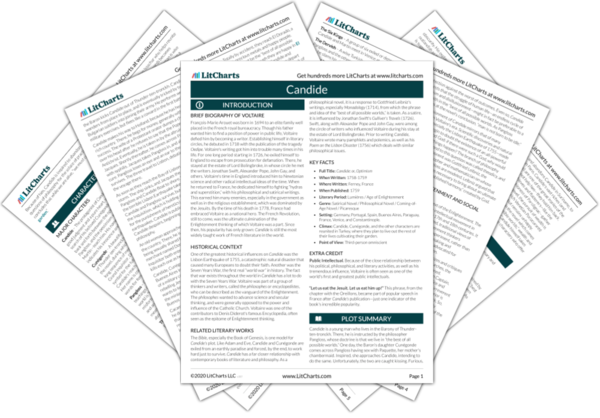Optimism and Disillusion
Candide pits the optimistic doctrine of Pangloss—that we live in the “best of all possible worlds”—against the long and senseless series of misfortunes endured by Candide and the other characters. Candide begins the novel as a faithful student of Pangloss, but painful experience prompts him to reconsider his views. Candide's disillusionment is gradual. As he sees more of life and the world, he becomes less and less convinced that suffering and evil exist as…
read analysis of Optimism and DisillusionThe Enlightenment and Social Criticism
Candide is a central text of the Enlightenment. The Enlightenment was an intellectual movement in Europe which flourished during the 17th and 18th centuries. It questioned, and often harshly criticized, traditional views of science, religion, and the state. Enlightenment thinkers believed in using reason and scientific experiment, rather than doctrine and custom, as a guide in the remaking and improvement of life and society. They also advocated for greater legal and social equality between men.
…
read analysis of The Enlightenment and Social CriticismReligion and Philosophy vs. The World
Candide satirizes the huge gap between the world and the way it is philosophically and religiously explained. The doctrines of religious groups and philosophers active during Voltaire’s life are made to look ridiculous and out of touch with reality when juxtaposed with the events of the novel. Pangloss' philosophy of optimism appears foolish—even insincere—when set beside the misfortunes of his life: exile, enslavement, execution, vivisection, syphilis, and academic obscurity. His explanations also become more…
read analysis of Religion and Philosophy vs. The World
Love and Women
Candide's search for Cunégonde is what threads together the novel's otherwise senseless sequence of adventures. The pursuit of Cunégonde, and of other women, is also the reason for the most of the characters' misfortunes: from the Candide's expulsion from Westphalia, to Pangloss' syphilis, contracted from Paquette. Candide uses women as a symbol of insatiable human desire (or perhaps, more specifically, male desire), a force which causes pain and conflict in the world. Women…
read analysis of Love and WomenWealth
Candide is a subtle critique of wealth and its pursuit. When Candide leaves El Dorado, laden with riches, it seems plausible that this newfound wealth will help him to find Cunégonde. Instead, it attracts no end of tricksters and hangers-on, from the Dutch merchant Vanderdendur who robs and abandons Candide in Suriname, to the imposter Cunégonde in Paris. Candide's vast riches (and their gradual disappearance) are one of the great ironies of the…
read analysis of Wealth






